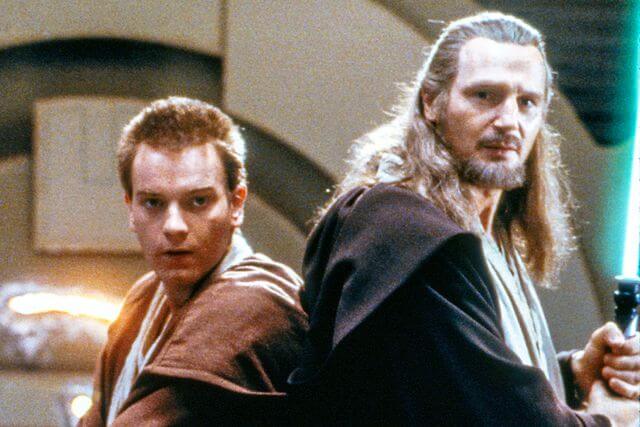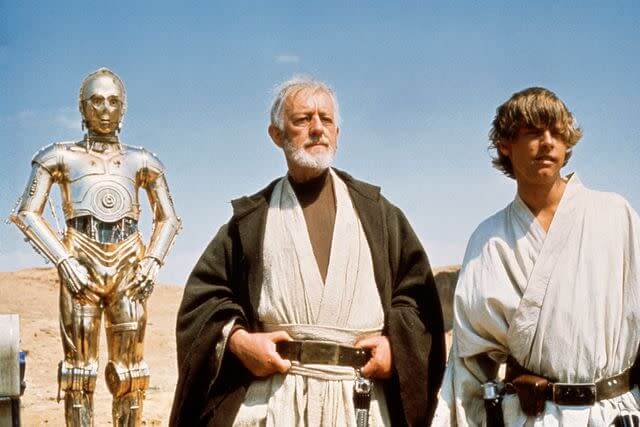No products in the cart.
World News
The Obi-Wan Kenobi Twist That Never Was: George Lucas’ Original Vision for The Phantom Menace
George Lucas’ Star Wars prequels, particularly Episode I: The Phantom Menace, introduced fans to the origins of iconic characters and the complex lore of the Jedi. However, recent revelations from concept artist Iain McCaig have unveiled a surprising twist that Lucas originally considered but ultimately cut: a storyline in which the identities of Obi-Wan Kenobi and Qui-Gon Jinn would be swapped. This twist, had it been realized, would have dramatically altered both the story’s trajectory and the future of one of cinema’s most beloved Jedi characters. Here’s a closer look at what this alternate vision entailed and its potential impact on the Star Wars saga.
A Bold Change: Obi-Wan as the Master, Qui-Gon as the Apprentice
In George Lucas’ early vision for The Phantom Menace, the dynamic between Obi-Wan Kenobi and Qui-Gon Jinn was envisioned quite differently from what fans ultimately saw on screen. Initially, Lucas conceived Obi-Wan as the elder Jedi Master, with Qui-Gon as the young, passionate apprentice. In this version, Obi-Wan would have been the one who ultimately dies, leaving Qui-Gon to carry on his legacy. This twist presented a fundamentally different relationship dynamic, with Obi-Wan embodying a wise, seasoned Jedi who mentors the spirited Qui-Gon. This portrayal would have been a departure from the young, somewhat impulsive Obi-Wan seen in The Phantom Menace, played by Ewan McGregor.

Lucas’ idea to switch their roles not only altered the story structure but also hinted at deeper, philosophical undertones about legacy, mentorship, and the power of names. Qui-Gon’s choice to adopt the name “Obi-Wan Kenobi” after the original character’s death would have introduced an intriguing element of transformation and honor. By embodying Obi-Wan’s teachings and carrying on under his name, Qui-Gon would bridge two eras of Jedi wisdom and courage, presenting a narrative rich with symbolic and emotional depth.
The Power of Names: Redefining Obi-Wan Kenobi’s Legacy
One of the most compelling aspects of this unused plotline was the symbolism attached to the name “Obi-Wan Kenobi.” In the original Star Wars trilogy, Alec Guinness’ Obi-Wan famously remarked, “Obi-Wan? Now that’s a name I’ve not heard in a long time.” Lucas’ early vision for The Phantom Menace added new layers to this iconic line by suggesting that “Obi-Wan” was not merely a name but a mantle passed from one Jedi to another. In this version, Qui-Gon’s decision to take on his mentor’s name after Obi-Wan’s death would reflect a journey of honor, sacrifice, and continuity—a way of keeping the spirit of Obi-Wan alive even after his physical passing.
This idea of name inheritance would have imbued Obi-Wan’s character with a mythic quality, enhancing his role as a figure of Jedi endurance and resilience across generations. It also would have added an interesting parallel to other characters in the series who adopt names or titles to signify their own transformations. By taking on Obi-Wan’s name, Qui-Gon would not only be fulfilling his mentor’s legacy but also embodying a vision of the Jedi as symbols rather than mere individuals. This added layer of meaning could have elevated the already profound themes of identity and legacy within the Star Wars universe.
Character Development: The Alternate Paths for Obi-Wan and Qui-Gon
With this twist, the characters of Obi-Wan and Qui-Gon would have taken on entirely different arcs. Obi-Wan, as the master, would have been portrayed as an established Jedi with a deep connection to the Force, serving as a guide not only to Qui-Gon but also to the audience’s understanding of the Jedi Order’s core values. His potential death early in the film would have created a sense of loss that mirrors the sacrifices often experienced by wise mentors in epic tales. This alternative portrayal could have added new layers to the audience’s understanding of the Jedi philosophy and underscored the tragic aspects of the Jedi Order’s commitment to peace, often at great personal cost.

Qui-Gon, as the apprentice, would have been positioned as a character coming into his own. His journey would involve grappling with the responsibilities and burdens of the Jedi, with his eventual choice to honor Obi-Wan by taking on his name symbolizing his growth. Rather than the seasoned and sometimes rebellious Jedi Master portrayed by Liam Neeson, Qui-Gon would embody the passionate and questioning nature of a young Jedi finding his place. This character arc would have resonated deeply with fans, providing a powerful exploration of mentorship, loss, and self-discovery within the Jedi Order.
Why George Lucas Ultimately Abandoned the Twist
Although the idea was rich with symbolic potential, George Lucas decided against this twist in favor of the more straightforward mentor-apprentice relationship between Qui-Gon and Obi-Wan. By positioning Qui-Gon as Obi-Wan’s master, Lucas simplified the narrative, focusing on Qui-Gon’s wisdom, compassion, and willingness to challenge the Jedi Council’s dogma. This decision allowed the story to introduce Qui-Gon as a guiding influence for Obi-Wan and, by extension, Anakin Skywalker, whose training as a Jedi becomes the catalyst for the trilogy’s events.
Lucas likely recognized that the traditional mentor-apprentice structure created a stronger foundation for Anakin’s journey. In this context, Qui-Gon’s tragic death at the hands of Darth Maul became a pivotal moment, spurring Obi-Wan’s resolve to train Anakin despite the risks. By preserving Obi-Wan’s original character, Lucas also ensured continuity with the existing Star Wars lore, particularly the well-established image of Alec Guinness’ Obi-Wan as a seasoned, wise Jedi. Maintaining the classic roles of master and apprentice allowed the narrative to stay grounded in familiar storytelling elements, which may have made the saga more accessible to both longtime fans and new audiences.
What Could Have Been: The Impact on Star Wars Canon and Legacy
Had George Lucas pursued his initial vision, the entire Star Wars saga would have been profoundly altered. The character of Obi-Wan Kenobi, as portrayed by Alec Guinness and later Ewan McGregor, has become one of the franchise’s most enduring figures, known for his sage advice, loyalty, and unwavering commitment to the Jedi Order. If Obi-Wan had been initially conceived as a fallen Jedi whose name was taken on by another, it would have shifted the character’s significance within the larger narrative. This approach would have blurred the lines of identity and legacy, creating a layered understanding of what it means to be a Jedi—and to honor those who came before.
Furthermore, this change would have impacted Obi-Wan’s relationship with Anakin Skywalker. Instead of a master who once trained Anakin, Qui-Gon would have become a peer who shared in the tragic events leading to Anakin’s transformation into Darth Vader. This twist would have altered the emotional dynamics of the original trilogy, potentially reshaping Anakin’s motivations and internal conflicts. In hindsight, Lucas’ decision to keep the original master-apprentice structure provided a clear and relatable storyline that helped solidify the relationships that fans have come to cherish.
Conclusion
The unused twist in The Phantom Menace is a fascinating glimpse into George Lucas’ creative process and the possible directions the Star Wars saga could have taken. While Lucas ultimately chose to present Obi-Wan and Qui-Gon in the classic master-apprentice roles, the alternative storyline serves as a powerful reminder of the depth and complexity of the Star Wars universe. The idea of passing down the name “Obi-Wan Kenobi” as a symbol of honor and legacy offers rich thematic material, and while it never made it to the screen, it reflects Lucas’ enduring commitment to exploring identity, sacrifice, and the transformative power of mentorship.
This revelation adds new layers of appreciation for The Phantom Menace, reminding fans that the Star Wars saga is as much about the stories that were told as it is about the ones that never were. Whether through familiar characters like Obi-Wan or through fresh ideas that were left unexplored, George Lucas’ vision for Star Wars remains a source of inspiration, sparking the imagination of generations of fans and creators alike.
From viraldes


